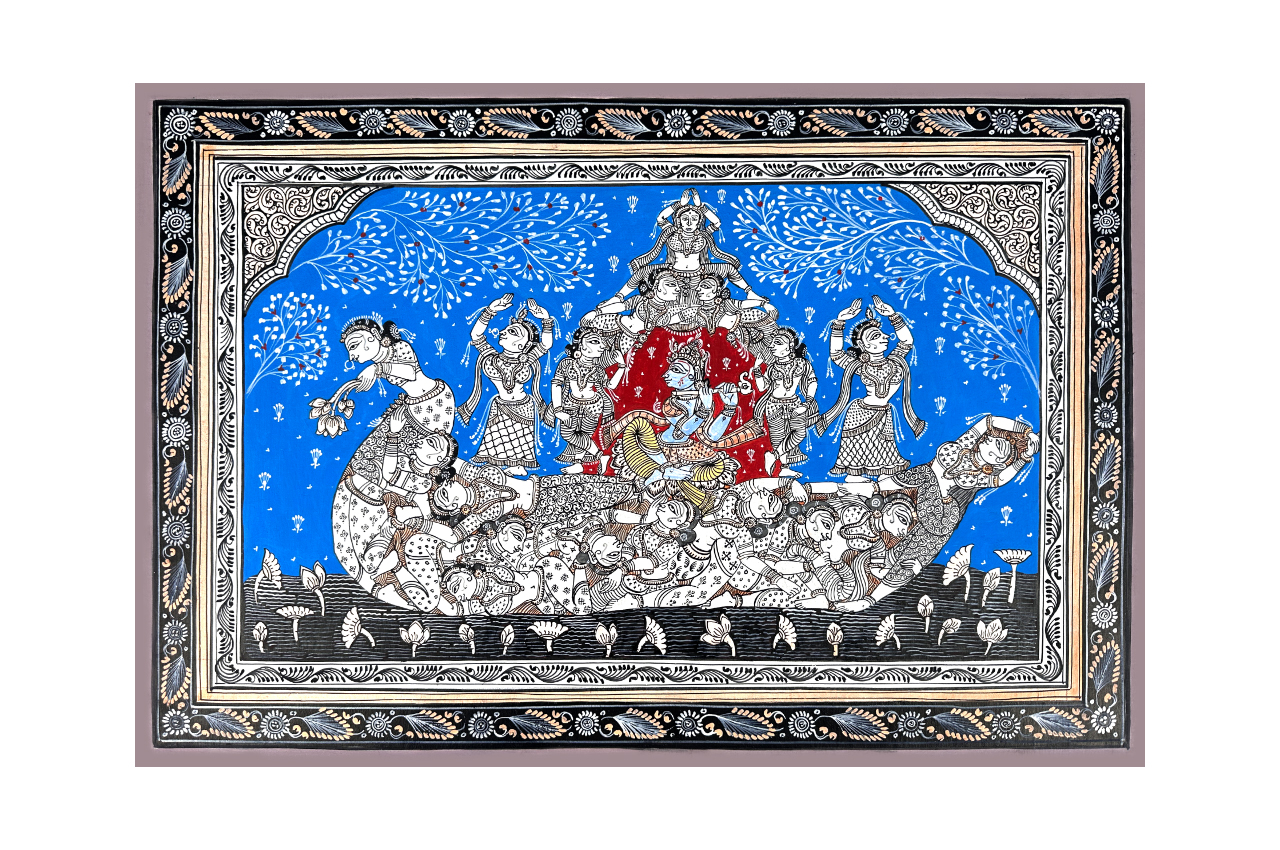Worldwide Fast & Safe Delivery | Oldest ISO 9001-2015 Certified Rudraksha Organization in the World | Your Trusted Brand Since 1997

Shopping Cart

Nauka Vihar Krishna Gopi Rasleela Pattachitra Painting
INR 13,680
Dimension: 13 (W) x 19 (H) inches
Product Code: PPO16
Quantity:
INR 13,680
Patta' means cloth and 'Chitra' means picture in Sanksrit. The multi-coloured painting takes us back to the times of Lord Jagganath. According to Skanda Purana, the Jyeshtha Purnima, or the full moon day in the month of Jyeshtha is celebrated as Lord Jagannath’s birthday. On Jyeshtha Purnima, Lord Krishna appeared as Lord Jagannath with dilated eyes, a round face and with His arms and legs shrunken, also known as mahabhava prakash, the ecstatic manifestation of Lord Krishna, Balaram and Subhadra. Lord Jagannath along with His brother and sister are ceremoniously bathed with hundreds of pots of water, milk and curd known as Snan Yatra. According to a legend, the Lord does not give darshan during anavasara. A day prior to Ratha Yatra, on Netrotsava, the Lord gives darshan.
Once Rohini maiya began to narrate the sweet nectarian Braja lila. It was decided that Subhadra would guard the door while the katha was being recited. Soon, she went into an ecstatic trance and completely forgot herself. Her arms and legs contracted and she became stunned.
Jagannath Puri dham is also known as Sri Kshetra. Sri is the Lord’s swarupa shakti, Lord Krishna’s internal potency. Therefore, the dhama which is glorified by the presence of Sri Shakti is known as Sri Kshetra.
The canvas is prepared by hand, using cotton cloth, tamarind seed gum and chalk powder. The indigenous natural primary colours used are prepared by the artisans themselves. Khadi (chalk powder) coats are applied firstly. After the coats are applied and polished, the pattis are trimmed on the sides and cut into required sizes. All figures are drawn to capture the essence of the legends and extent in proportion to one another and to the background.
Only earth stone, vegetable and mineral colours are used to paint the pattas. Basically, primary colours are used in patta painting like sankha (white), Hingula (red), Harital (yellow), deepa kala (black), dhau (brown) and neela (indigo). The gum used with the colours is obtained from kaphitha tree (wood apple) and mixed with a coconut shell. The Chitrakars of Puri follow a different procedure which is based on several applications following one after the other such as Tipana(sketch), Hingula Banaka (background colour filling), Ranga Banaka (character colour filling), Alankarlagi (ornamental work), Motakala (thick black line),Sarukala (fine black line), Ranga Lekha (fine ornamented work), Chhitadia (design work), Sankha patta (finishing touch with white colour) and Dhadikama (border design work).
The cultural history of Orissa can be traced to pre-historic times. The history of art in Orissa began with the Mauryan rule over Kalinga in ancient Orissa, when stone was used as the medium of art. The first specimens of plastic art in Orissa date back to the third century B.C. found at Dhauli near Bhubaneswar and Jaugarh in the district of Ganjam. Later, the art activities in Orissa were influenced by the contemporary all India trade from first century BC. uptil fourth or fifth century A.D. From seventh century onwards, several royal dynasties ruled in succession over ancient Orissa and the political and cultural life became clearer. The sculptural art took a definite shape during this period by building beautiful temple complexes in Bhubaneswar and other places in Orissa. According to the royal patronage and teachings of Vaishnav scholars, the tradition of Patachittra paintings has been associated with the Jagannath temple in Puri in the Ganga period (Circa A.D 1110 to 1435).
Dimension: 13 (W) x 19 (H) inches
Add a Review:
Affiliations


Why Choose Us?
World’s Oldest & Most Trusted Website on Rudraksha, Gemstone, Pujas, Spiritual Products & Services.
Achieve Healing, Empowerment & Success With RRCT.
Credibility Since 1997
Fastest Delivery
Expert Advise & Counselling
Worldwide Distribution
Vedic Pooja Energisation
Over 100,000 + Testimonials
Join Our Newsletter